| Ten-Cent Mortising Gauge --
Using a dime to set the all-important gap between the mortising
bit and the mortising chisel. |
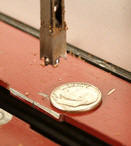 |
Stop Collar Vernier Tapes --
Stick-on measuring tapes you can use to adjust your table height
in thousandths of an inch. To download tapes you can
print and apply, click HERE. |
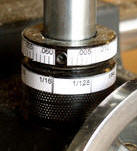 |
| Belt
Sander Fence -- A simple fence that mounts to the belt
sander and helps to sand parts square and true. |
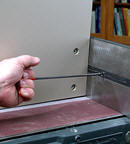 |
Preventing
Router Bit Slips -- How to keep your router bit from
slipping in the collet without having to overtighten the
compression nut. |
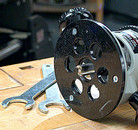 |
| Avoiding "Back-routing" --Feed the wood past your router in the wrong direction, the bit
will pull the wood away from the guide. This is known as
"back-routing." It can ruin your work and cause a dangerous
kickback. See how to determine the correct feed direction |
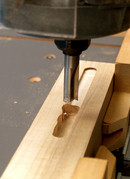 |
Auxiliary
Fence for Sliding Table -- This
ingenious add-on fence for the Shopsmith Sliding Table let's you
use our Flip Stop and our Magnetic Rule as you crosscut, adding
convenience and precision to your operation. Click HERE to download plans. |
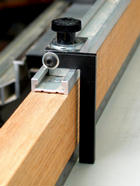 |
| Turning precise cylinders -- Using parts of the Shopsmith
Lathe Duplicator, you can make make cylindrical turnings as straight as a die, create round tenons that fit their mortises perfectly, and turn wood to precise
diameters. |
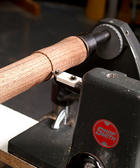 |
Sanding Plywood Banding --
Shopsmith's newest accessory, the Sand Flee finishing
sander, offers the control you need to sand delicate assemblies. See
how to flush-sand hardwood edging or "banding" on plywood
while barely touching the veneer |
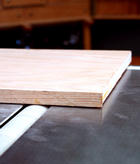 |
| Zero
Clearance Inserts -- Small wooden parts may fall through
the saw insert and be chewed up or flung back at you.
Prevent both these problems with zero-clearance inserts. |
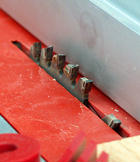 |
Making Wooden Trivets -- An easy-to-make
gift -- wooden trivets to keep hot dishes from scorching countertops.
Just make several dado cuts
on both sides of the stock. Includes plans for trivet-making jig;
click HERE. |
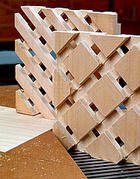 |
| Abrasive Cleaning Stick -- The abrasive cleaning stick is
designed to remove impacted sawdust from sanding disks and sanding
belts. But it will do a few more chores around your shop. |
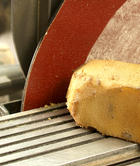 |
Using a Boring Bar for Lathe Turning -- A "boring bar" will
turn the inside of a bowl quickly and easily. And if you have a Lathe
Duplicator for your Shopsmith, there's no need to buy a boring bar;
you can make your own! |
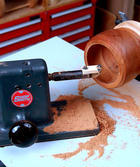 |
| A Long Handle for the Footswitch -- Attach a long
scrap of wood to the side of a footswitch to serve as a handle,
making it easy to move without bending down. |
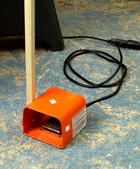 |
Making Biscuit Joints in the Middle of a Board -- A clever trick for cutting
biscuit slots midboard, using the Biscuit Joiner in the horizontal position. Good for joining the end of a board to
the face of another. |
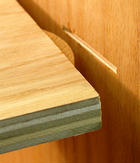 |
| Using a Cone Cutter
to Shear on the Lathe Duplicator -- The Cone Cutter produces
a supper-smooth surface. The
rim of this unique tool is ground to shear the wood as it
turns rather than scrape it. |
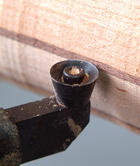 |
Sharpening Knives
on the Strip Sander -- With the strip sander and a
sharpening attachment, you can put a razor-sharp edge on all
kinds of knives. Includes plans for a knife-holding jig to grind a precise angle. |
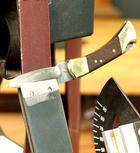 |
| Double Bar Clamp Veneer Press -- Using several double bar
clamps, you can create a "veneer press" that spreads pressure evenly
over an entire panel when gluing veneer to a wooden backing. |
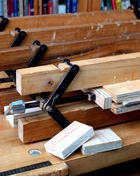 |
Lower
Saw Guard Maintenance -- The spring-loaded posts on the
Lower Saw Guard desperately
need periodic lubrication or they will begin to hang up. Here's how
to keep them in good working order. |
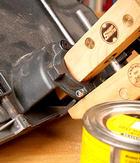 |
| Aligning a
Workpiece for Crosscutting -- When you mark the face of a
board for a crosscut, use a small Engineers Square to align it
precisely with the saw blade before you make the cut. |
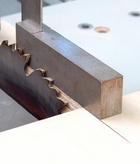 |
Making Square
Corners with Corner Squares -- When you need an assembly to be perfectly square, use these handy clamping jigs to keep all your corners
true. Make dozens from a few
plywood scraps. Includes FREE plans. |
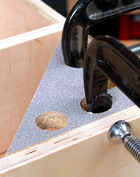 |
| The Trick to
Using Hand Screws -- Although extremely versatile,
hand screws can seem awkward to a novice. There's a simple trick
that not only makes them easier to use, but also opens up all the capabilities of
this tool. |
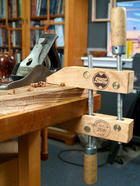 |
"No
Slip" Glue Tip -- When gluing boards
together, the pieces often slip out of alignment. Here's a common
material that all
craftsmen keep in their shop and that you can use to prevent this from
happening. |
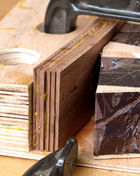 |
| Sharpening Curved Scrapers -- Putting a burr on the edges of curved
scrapers can be hit-or-miss with an ordinary burnisher. But the
shank of a drill will raise an even burr no problem. |
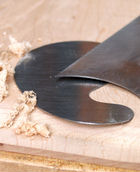 |
Removing
Rust with Potatoes -- Want to remove rust without a lot of
elbow grease? Let a couple of potatoes do all the work
for you! They have a chemical "chelator" that lifts the rust
off the metal. |
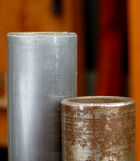 |
| Collecting Sawdust While Drilling -- When
drilling, the Shopsmith makes a lot of chips
that can interfere with the accuracy of
you’re work. This mess can also prevent you from seeing the
layout. Here are two easy ways to pick up the dust and chips
as you drill. |
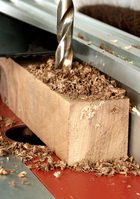 |
Lift Assistance
for the Table and Headstock -- In the
drill press mode, it may be difficult to adjust the vertical
position of the Shopsmith table
and headstock. You
can make the task much easier by raising and lowering them
with a bottle jack! |
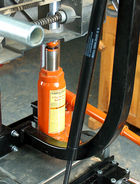 |
| Stacking Featherboards -- We show you
how to set up the Shopsmith band saw for resawing with one or more featherboards to keep
the board properly positioned. FREE plans for the jig! |
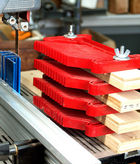 |
Cleaning Up Epoxy and Silicone -- There's
nothing quite so sticky
as epoxy adhesive and silicone caulk. However, a simple,
inexpensive household chemical will wipe away these materials |
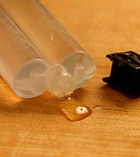 |
| Undercutting a Tenon -- When fitting tenons to
mortises, woodworkers sometimes employ a technique called
"undercutting." to get the tenons to fit as tight as possible.
Here's how it's done |
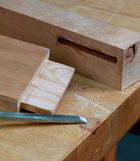 |
Curing Planer Woes -- Occasionally you planer bed "sticks"
because impacted sawdust has fouled the threaded posts and
prevents you from turning the crank. Here's how to clear the threads safely. |
 |
| Wrapping a Board Around a Box -- When good craftsmen build boxes
they plan their cuts so the wood grain appears to be
continuous around the assembly. This takes
some careful planning, but the visual effects are well worth the
effort. |
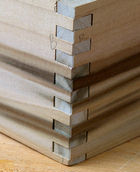 |
Compound Miters with Sliding Table -- Despite their precision,
few sliding tables can cut compound miters (with both
the miter fence and table angled) as they cannot be used on
both sides of the blade. Our "Antigravity Miter Jig"
changes all that. FREE plans! |
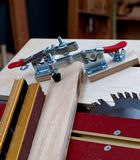 |
| Waxing
Sliding Tables, Clamps, and Jigs -- Paste wax is a good all-around
lubricant for the sliding surfaces of tools, both store-bought
and shopmade -- and can also be used to protect the surfaces of tools
from glue. |
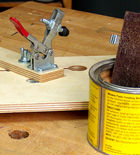 |
Band
Saw Extension Tables -- When the band
saw table doesn't provide enough support to cut large workpieces,
use the auxiliary tables and a set of 5-foot extension tubes to
build acres of
support on all three working sides of the saw. |
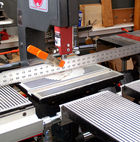 |
| No Room
for Wiggle -- When performing operations that
require precision, the main table must be
stabilized. Because it's mounted on just two posts, there may be
a little "wiggle room" However, it's a simple matter to
reinforce the table with parts from the Shopsmith system. |
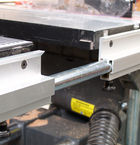 |
Jointing
Veneers -- When
cutting veneers to cover a surface, you often have to join the
sheet edge to edge or end to end. Here's a simple way to "joint"
the adjoining surfaces so they will fit perfectly. |
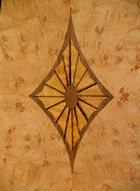 |
| The Essential
Bench Hook -- One of
the most useful shop jigs is also one of the easiest to make.
The "bench hook" provides a backstop, a cradle, or a brace for
dozens of woodworking operations. Includes FREE PLANS. |
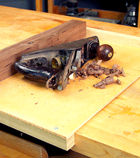 |
Building a
Rock-Solid Work Surface -- The connecting tubes that come with
the Mark V 510 and 520 don't just allow you to build large work
surfaces. Properly employed they will more than double the
stability of your setups, making you work more precise. |
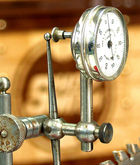 |
| Building a
Work Surface -- Shopsmith's auxiliary tables allow you to build
large work
surfaces. But you don't have to just string them together. You can also create infeed and outfeed
surfaces -- even extended surfaces for special purpose tools. |
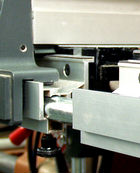 |
Drilling with Accuracy -- When you drill a hole with a drill
press, wear and minor imperfections in the parts all conspire to make your bit hit
wide of its mark. But with a few judicious adjustments, you
can put your holes where you want them. |
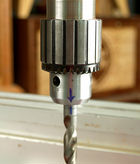 |
| T-slot Jigs -- The Shopsmith table and fence comes with T-slots for
mounting jigs and accessories. Here are three T-slot jigs,- a
fence extension, overhead fence, and tenoning jig, plus the FREE PLANS to make
them. |
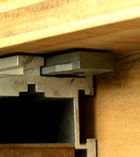 |
Toxic Woods -- Effective diust collection is important tp your health,
espcially if you work with "toxic" woods known to cause physical
reactions. Includes and FREE CHART of toxic woods and the risks they pose. |
 |

